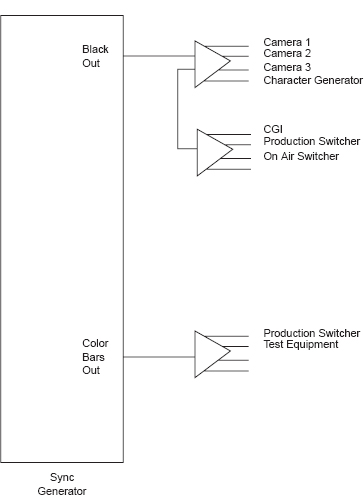The electrical paths can be diagrammed
Analog Sync Flow Diagrams
Where do the various sync, drive, and blanking pulses go? The easiest way to illustrate the paths of these components is by using flow diagrams. Flow diagrams are very handy things to be able to read. They use geometric shapes to represent various pieces of equipment, and lines to represent the wires that connect the equipment. Flow diagrams enable you to see how the various components of a video system are integrated electronically. Most studios are designed using flow diagrams since, if something needs to be changed, it's much easier to erase something on a diagram and draw a new line before a studio is built than it is to rip out a wall to add a new cable after the studio has been finished.
Take a look at the sync flow diagram. This diagram is an electrical map of a typical studio video system. It charts the electrical pulses going into the cameras, as opposed to the camera flow diagrams (discussed later) that trace the electrical flow leaving the cameras. On the left-hand side of the diagram is a box labeled Sync Generator. On the left side of the box is an output labeled Black (reference or black burst). Rather than having separate outputs for each of the drives blanking, and sync pulse we use black burst, sometimes just called the reference signal. Black burst is analogous to a composite video signal but instead of having a picture it has black.Thus, it carries all of the necessary sync signals with it. This is what the other equipment in the studio lock up to.
Distribution Amplifiers
Follow the path of the reference signal. You'll see that the path goes to the right and comes to a triangle that is labeled DA 1. That stands for distribution amplifier. A distribution amplifier is a piece of equipment that takes an input signal and gives you multiple output signals of that same input signal. So if we have a reference signal coming into the pulse DA, our diagram shows that we have six of the same reference signals coming out of it. This is very handy since, unlike home video and stereo, you can't use splitters and other such items because they degrade the signal too much. As its name implies, the distribution amplifier avoids this problem partly by amplifying the multiple outputs it produces. The first output goes to camera 1, and the second goes to camera 2.

